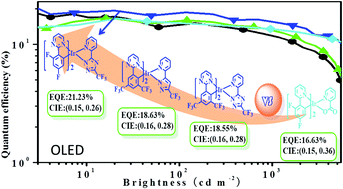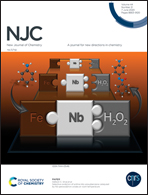Sky-blue iridium complexes with pyrimidine ligands for highly efficient phosphorescent organic light-emitting diodes
Abstract
Blue iridium phosphors are always precious and desirable for both fundamental research and industrial applications in organic light-emitting diodes (OLEDs). Three heteroleptic cyclometalated iridium(III) complexes, namely, Ir1, Ir2 and Ir3, incorporating 2-(3,5-bis(trifluoromethyl)phenyl)-pyrimidine (tfmphpm) or 2-(2,4-difluorophenyl)-pyrimidine (dfppm) as the main ligand, and 2-(3-(trifluoromethyl)-1H-pyrazol-5-yl)pyridine (fppz) or 2-(5-(4-(trifluoromethyl)phenyl)-2H-1,2,4-triazol-3-yl)pyridine (Htaz) as the ancillary ligand, were developed for application in OLEDs. Owing to the introduction of the strong-field CF3-containing ancillary ligand and the incorporation of electron-withdrawing F or CF3 groups on the HOMO-lying C-related aromatic rings of the C^N cyclometalating ligands, the phosphorescence of these Ir(III) complexes peaked at 457–459 nm. In comparison with the well-known commercial sky-blue iridium complex FIrpic (bis(4′,6′-difluorophenylpyridinato) iridium(III) picolinate, 475 nm), the phosphorescence of these complexes is hypsochromically shifted by 16–18 nm, more closely approaching standard blue light. They have high phosphorescence quantum yields in solution. The phosphorescent OLEDs employing these complexes as doped emitters display impressive performance. In particular, the PhOLED based on Ir3 achieves an outstanding maximum external quantum efficiency of 21.23% with Commission Internationale de l’Eclairage (CIE) coordinates of (0.15, 0.26), which is about 27% higher than that of the control device using FIrpic as a dopant (16.63%).



 Please wait while we load your content...
Please wait while we load your content...